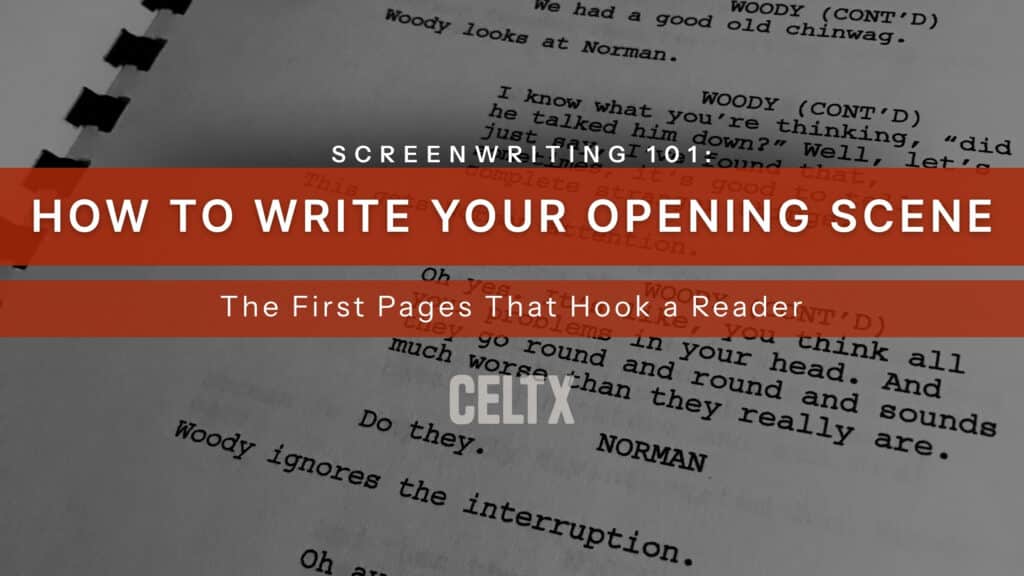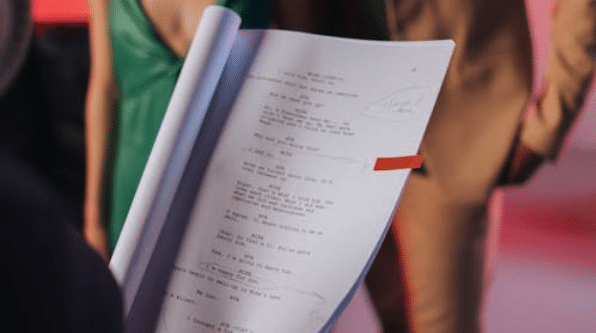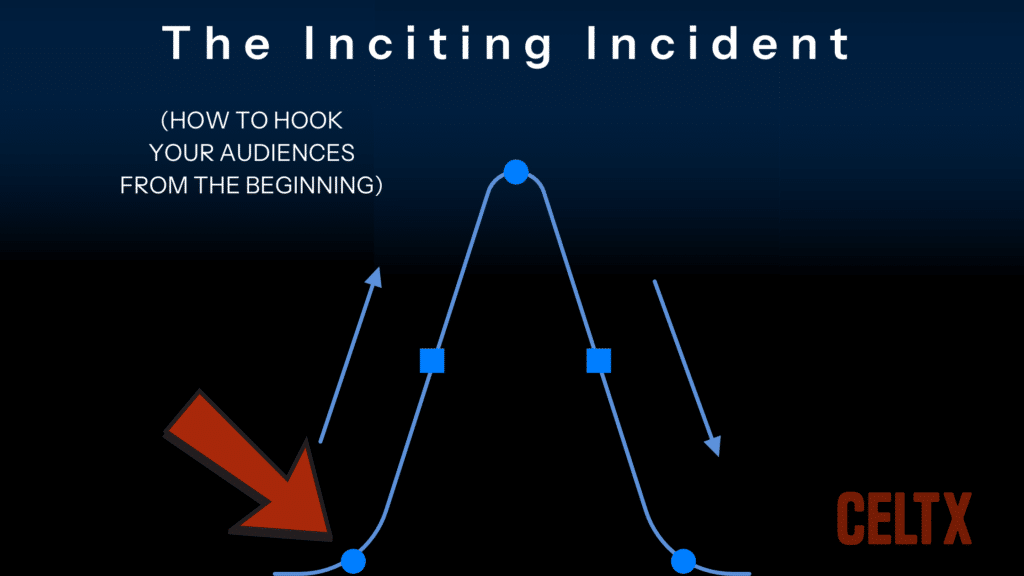
Every writer has been there: staring at that blinking cursor, heart thudding like a drum solo, wondering “Where the heck do I start?”
You know the story you want to tell. You can already picture the sweeping finale, the gut-punch twist, the emotional payoff that will leave your audience gasping. But before any of that can happen, you’ve got to start at the beginning. The first few pages that will either grab your audience by the collar… or send them scrolling to the next script, book, or submission.
It’s no exaggeration to say your opening scene can make or break your story’s chances. Agents, producers, and readers all have one thing in common: limited time and infinite options. Which means the first ten pages of your story are your audition.
So, how do you make them unforgettable? Well, that’s what today’s blog post is all about. We’ll focus on how you can create the best first impression as well the essential elements your first ten pages need.
Let’s break it down.

Table of Contents
- The Crucial First Impression
- The 10-Page Test
- The Four Essentials of a Strong Opening Scene
- The “In Medias Res” Approach
- Establishing Tone & Atmosphere
- The First Line of Action & Dialogue
- Practical Examples: Comedy vs. Horror
- FAQs
- Conclusion
The Crucial First Impression
Imagine you’re at a party. Someone new walks in, and within ten seconds, you’ve formed an opinion. It’s not fair, but it’s human nature. Your story’s opening works the same way.
From the opening image, readers subconsciously ask:
- What kind of story is this?
- Who am I supposed to care about?
- Why should I keep reading?
If your opening scene doesn’t answer those questions fast and with confidence, you risk losing them before you’ve even started.Think of your opening scene as a handshake with personality that shows us who you are as a storyteller. Are you sharp? Funny? Intense? Atmospheric? Readers should be able to tell within a page, and easily link it to your logline.
The 10-Page Test
In the film and TV world, there’s a brutal truth known as “The 10-Page Test.” That’s how long you get, if you’re lucky, to convince someone your script is worth finishing.
If a reader hits page 10 and still doesn’t know what the story is about, who the main character is, or what kind of tone they’re in for, your script goes in the “pass” pile.
For novelists, the metric is similar. Agents and editors rarely read past the first chapter unless those early pages sparkle. It’s not because they’re cruel, it’s because they know the opening scene is a microcosm of the entire work. If the opening doesn’t engage, odds are the rest won’t either.
So, when you’re writing your first scene, ask yourself: “Would I keep reading if I knew nothing about this story?”
If your honest answer is “maybe,” it’s time to turn “maybe” into “hell yes!”
The Four Essentials of a Strong Opening Scene
A great opening scene is like a perfect cocktail: balanced, distinctive, and immediately intoxicating. And like any good recipe, there are a few core ingredients you can’t skip.
1. Genre: Set the Expectation
Readers want to know what kind of ride they’re on. Whether it’s a rom-com, thriller, or fantasy epic, your opening scene should establish the genre through tone, imagery, and rhythm.
- Romance: start with tension, chemistry, or longing.
- Horror: open with unease, dread, or something slightly “off.”
- Comedy: deliver irony, absurdity, or contrast right away.
- Action: throw us into motion—literally or emotionally.
If the story’s genre doesn’t reveal itself in the first scene, readers feel unmoored. It’s like watching a movie trailer that refuses to tell you whether it’s a comedy or a tragedy.

2. Tone: The Emotional Vibe
Tone is about how what happens feels to an audience. Are we supposed to feel tense? Playful? Melancholic? The atmosphere you establish in your opening will shape how readers interpret every line that follows.
Use sensory details, pacing, and rhythm to create this emotional undercurrent. A horror opening might lean on short, staccato sentences and shadows that don’t behave. A romantic comedy might open with snappy dialogue and chaotic energy. A sci-fi epic might start with curiosity and awe.
3. Protagonist: Give Us Someone to Care About
It doesn’t matter if your protagonist is a thief, a queen, or a morally confused space pirate; we need to feel something for them right away.
That doesn’t mean we have to like them. But we do need to understand them through a trait, flaw, or desire that makes them relatable.
Avoid lengthy backstory dumps or exposition. Instead, let us meet your protagonist in motion, doing something that reveals who they are. Whether it’s a small choice or a big mistake, action always tells the truth faster than description.
4. Inciting Incident Tease
Notice I said tease, not deliver. You don’t have to throw your protagonist into the central conflict on page one, but you should hint at it. The first scene should whisper, something big is coming to keep us reading.
A single detail, unanswered question, or moment of tension can serve as a promise that change is on the horizon.
The “In Medias Res” Approach
Latin for “in the middle of things,” in medias res is one of storytelling’s oldest tricks, and when done right, it’s magic.
Starting in the middle of the action means you skip the warm-up and drop readers straight into a moment of tension or conflict.
But “In the middle of things” doesn’t mean chaos for chaos’s sake. Opening with explosions, car chases, or screaming matches can backfire if we don’t yet care who’s involved or what’s at stake. The best “in medias res” openings balance motion with meaning.

Good example: A character is running, not from an explosion, but from a wedding altar. Immediately, we ask: Why is she running? What happened?
Bad example: A character is running, and we don’t know who, where, or why. That just causes confusion rather than incites intrigue. So, by all means, start in motion but give readers just enough emotional context to latch onto.
Establishing Tone & Atmosphere
You know those stories that grab you not because of what happens, but how it feels? That’s atmosphere, and it starts with your scene’s world-building.
The setting of your opening scene is a character in its own right and sets the emotional temperature, influences pacing, and reveals hidden truths about your protagonist.
Want to establish tone through atmosphere for yourself? Try these:
Contrast
Place your character somewhere that clashes with their mood or goals (a bright wedding during heartbreak, a sunny beach before tragedy).
Detail
Use sensory precision like smells, textures, sounds to ground us in the moment.
Action Lines
In screenwriting, this means writing visually. Cut fluff like “We see” or “There is.” Instead, write something like:
The neon flickers. A cockroach scuttles over spilled beer.
Your goal isn’t to describe everything but to make us feel something specific.
The First Line of Action & Dialogue
Let’s talk about your story’s first line. It’s your story’s handshake, first impression, and thesis statement all in one. Whether it’s an action line or a spoken line, it sets the rhythm for everything that follows.
If it’s action, keep it tight, vivid, and specific. Don’t waste your first line on setup or scene direction. So instead of:
We open in a restaurant where a man appears to be bleeding.
Try:
Blood drips onto the white tablecloth.

And if it’s dialogue, make sure the line reveals character or conflict. Dialogue that sounds generic kills momentum faster than an overused voiceover. So, instead of:
Hi, how are you today?
Try:
You call that a clean getaway?
Every word in your opening scene should feel necessary. If a line doesn’t build tension, reveal character, or establish tone, cut it.
Practical Examples: Comedy vs. Horror
Let’s see how all this theory plays out in practice and sets out the themes and tone in two very different genres.
Comedy | The 40-Year-Old Virgin (2005)
Judd Apatow and Steve Carell’s The 40-Year-Old Virgin starts with character truth. It’s a hook built on recognition, tone, and empathy through laughter.
Andy (Steve Carell) wakes up and goes through his morning routine. He’s cheerful, awkward, and utterly ordinary. The visual joke becomes clear: this guy is sweet but stuck in his own world. We don’t need a title card to know the setup; the details do the work.
The sequence works because it doesn’t try too hard to be funny. The humor arises from authenticity, not slapstick. We instantly understand this is a character-drive, heartfelt, and observational kind of comedy.
Within a few minutes, we know who Andy is without voiceover or exposition. This is how comedy openings should work: show us who we’re rooting (and laughing) for. And by the time the title drops, we’re hooked, wondering what’s missing and what happens when this guy finally steps out of his comfort zone.
Horror Opening Example | Scream (1996)
Scream, written by Kevin Williamson, has one of the most famous cold opens in film history. It’s a masterclass in how to grab an audience by the throat, literally and figuratively.
A teenage girl, Casey Becker, answers her ringing phone. The voice on the other end is charming at first but soon turns sinister. Within minutes, she’s trapped in her own home, playing a deadly game of movie trivia with a masked killer. The entire sequence plays out in real time.
The story begins in motion and within seconds, we’re inside the tension. There’s no exposition, no backstory dump, no “previously on.” It’s happening now.
We meet Casey for only about ten minutes, but we care. She’s likable, vulnerable, and very human through her nervous laughter, her small talk, her attempts to stay calm. That connection makes the violence that follows even more shocking.
We also know exactly what kind of film we’re watching: a self-aware, brutally suspenseful slasher. No one is safe. Killing off your most recognizable actor in the first scene sets the rules (or lack thereof) for everything that follows. It’s a promise to the viewer that this story won’t play by the book.
For more standout opening scenes, let’s hear from Learning About Movies and his analysis of some of the best out there:
FAQs
There’s no one-size-fits-all answer, but brevity is your friend. Your opening scene should last just long enough to set the tone, introduce the protagonist (or at least the prospective character), and hint at the central conflict or question.
In screenplay terms, that’s often 1–3 pages. A good test: if you removed your first page entirely, would the story still make sense? If the answer is yes, you might be starting too early.
The 10-page test is an industry shorthand for the make-or-break first impression. Executives, agents, and readers often give a screenplay about ten pages (sometimes less) to prove it’s worth their time. Within those pages, they want to feel the hook, the world, the tone, and a sense of momentum.
Essentially, it’s a challenge: Can your story convince someone to invest their attention in just ten pages?
It can be, but handle with care. Flash-forwards can work beautifully when they build intrigue rather than confusion. For instance, starting with a glimpse of your hero bloodied and desperate before cutting back to “24 hours earlier” can create tension if the audience quickly understands what’s happening and why it matters.
However, a flash-forward shouldn’t exist just to shock or “spice up” an otherwise slow beginning. It must serve the story.
Most of the time, yes, but not always. Including your protagonist right away helps the audience form an emotional connection early. We want to know whose story we’re in and why we should care.
That said, there are great exceptions. Some stories open with a secondary character or even a nameless figure, especially in genres like mystery, thriller, or horror, where the goal is to establish tension or tone before meeting the hero. Think of the opening of Jaws: we meet the shark’s victim, not the sheriff.
Conclusion
Your opening scene is the heartbeat of your story, the moment that tells readers, “Trust me, this is worth your time.”
Whether you’re crafting tension like Scream or character warmth like The 40-Year-Old Virgin, the goal is the same: to spark curiosity and set the tone. Start where the story truly begins, make every line earn its place, and let your first pages whisper a promise your story is ready to keep.
Because once you’ve hooked your reader, the rest of your world is theirs to explore.
Ready to write your killer opening scene? Start writing today, it’s free.
Up Next:

The Inciting Incident: 5 Steps to Hook Audiences from the Start
Once you’ve nailed your opening scene, it’s time to kick your story into gear. Learn how to write the moment that changes everything and propels your characters forward.
